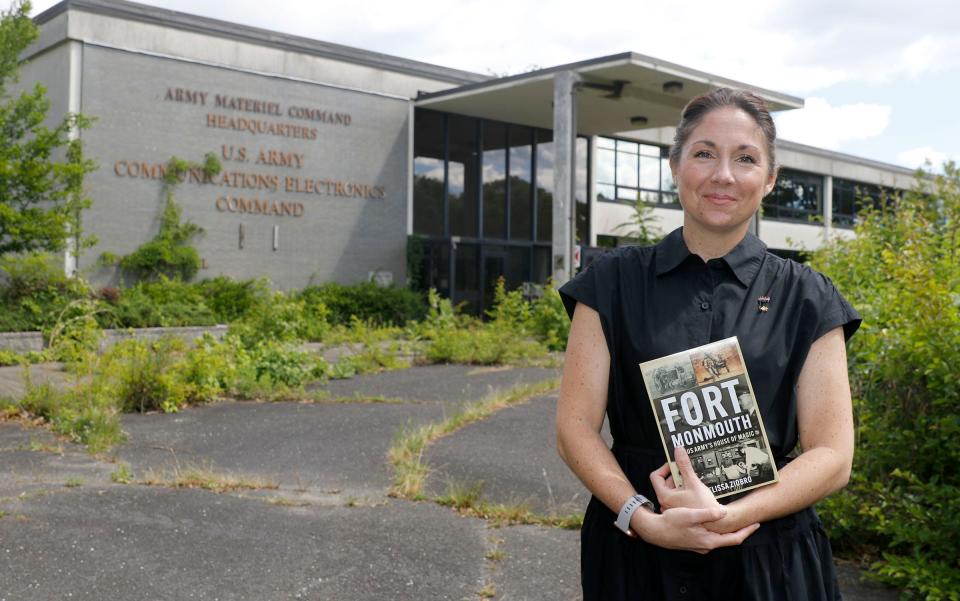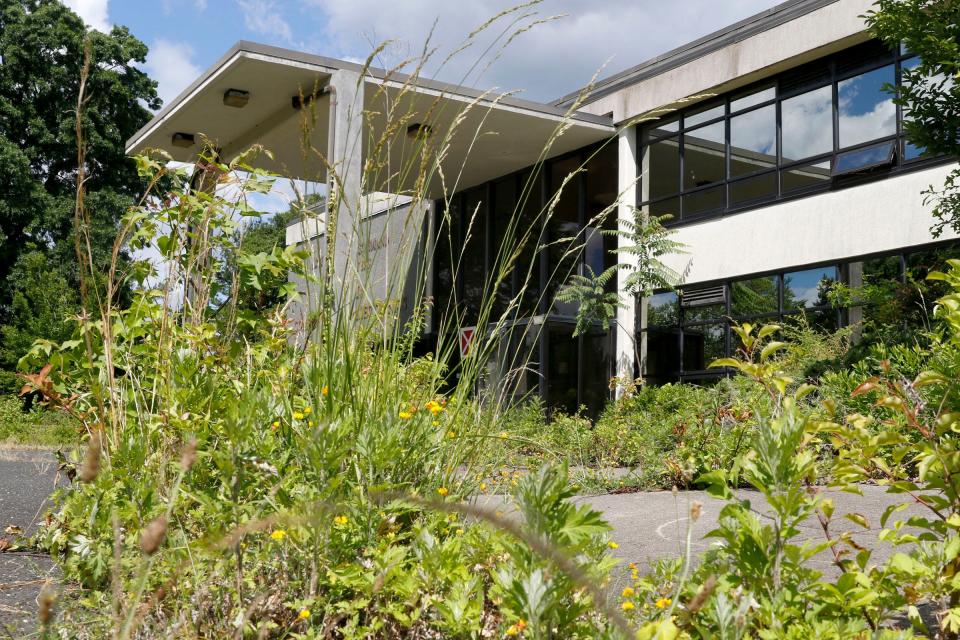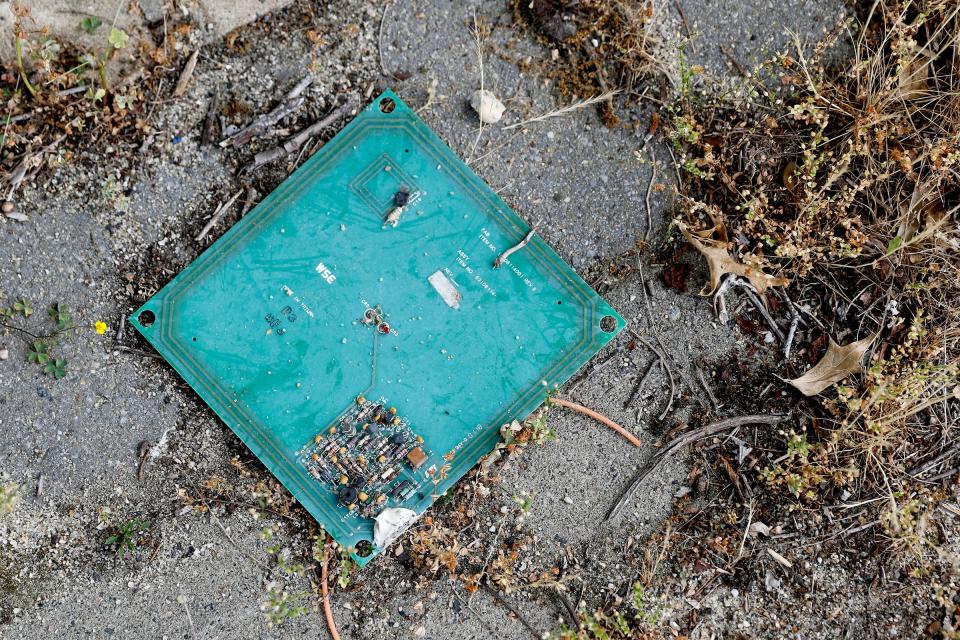Historian reveals inside story of Army's 'House of Magic' at Fort Monmouth
In the waning days of Fort Monmouth, Melissa Ziobro, the post's last historian, boxed up the archives, sent them to the operation's new home in Aberdeen, Maryland, and returned in September 2011, when the flag was lowered for the final time.
Ziobro couldn't move to Maryland; she was pregnant with her second child and her husband had a steady job as a police officer in Brick. She took a teaching job at Monmouth University in West Long Branch instead.
"I just remember sobbing and saying, 'I'm going to keep this history alive here in the state,'" Ziobro said.
Ziobro has made good on her promise. Her book, "Fort Monmouth: The U.S. Army's House of Magic," was published this spring, walking readers through an institution that left its stamp on the military and civilians alike. Employees stationed there helped develop radar, FM backpack radios that relayed messages static-free and satellite technology.

Fort Monmouth history: From poison ivy and pigeons to Netflix TV production
The book comes as the Fort Monmouth property, abandoned 13 years ago, prepares for a splashy new life. Netflix has announced plans to build one of the world's biggest entertainment production studios on 300 acres there, potentially transforming the local economy.
While Netflix's arrival has generated a Hollywood-style buzz, former Fort Monmouth employees said they hope the Army post's legacy won't be forgotten.
Netflix at Fort Monmouth: It may get $125M in NJ tax breaks; first studios could be up by 2027

"The project Melissa did capturing the history of Fort Monmouth is invaluable," said Lt. Col. John Occhipinti, retired, who managed the site during the closure. "There was a deep tie between this area and that little fort. Militarily speaking, it's a small fort in size, in acreage. But in its impact on the mission, it's huge."
Ziobro, 41, lives in Toms River with her husband, John. They have two sons, JP, 16, and Donovan, 12.
Ziobro, who started working at the fort in 2004, shortly before she graduated from Monmouth University, has a new job: She's the curator of the Bruce Springsteen Archives & Center for American Music at Monmouth. But even now, she sees the connections to Fort Monmouth wherever she turns, noting Springsteen played at Fort Monmouth in 1965 when he was a member of the Castiles.
The inside story: How Fort Monmouth got Netflix and one of the world's biggest movie studios
She sat down with the Asbury Park Press this week to discuss her book. Here are five things you need to know about Fort Monmouth's history:
1. Rail, water and roads
The property in the late 19th century was home to Monmouth Park, where wealthy visitors to the Jersey Shore watched horse racing — until the state outlawed gambling. In 1917, with World War I underway, the U.S. Army needed to develop communications for a force that was ramping up.
"Communications is going to be key on the enormous battlefields, particularly the western front," Ziobro said. "The Army goes out looking for land for Signal Corps training camps and they stumble across this site. And part of the reason they pick it is proximity to rail terminals to get material in and out; proximity to Hoboken, which is going to be a major point of embarkation shipping troops off to Europe; access to water; and then stone roads that were in the area from the racetrack days that would facilitate being able to move people and material quickly."
Netflix at Fort Monmouth: Find out where the studios, helipad and hotels can go

2. What ifs
Col. William Blair, an Irish immigrant who moved to the U.S. when he was 9, became director of the Signal Corps laboratories and focused on using radio waves to detect enemy aircraft and ships before you could see them.
The research led to radio detection and ranging, or radar. The new technology was in place at Pearl Harbor and detected incoming Japanese planes. But it was untested; the soldiers manning the radar were told it was probably just picking up a flock of birds or U.S. planes.
'I saw the blip': Long Branch radar operator's Pearl Harbor warning was ignored
"Historians today debate how much time they actually would have had to mobilize the fleet, to mobilize the planes," Ziobro said. "I don't know that it would have actually changed everything around, but you could feel (the) distress there, thinking that we developed this amazing technology and it wasn't deployed successfully. But radars will then go on to make a decisive difference in World War II."
3. The Army's secret weapon? Pigeons
The fort was home to the Pigeon Breeding and Training Center, where the birds learned to fly two-way missions under the cover of darkness to deliver messages. The Army eventually equipped them with cameras to perform reconnaissance.
The service ended in 1957, but years later, soldiers in the battlefield would ask for them.
"One of my favorite items in the archive was this handwritten letter from a soldier in Vietnam, and he's writing to the commander at Fort Monmouth," Ziobro said. "And I'm paraphrasing, but he says something along the lines of, 'Sir, all of these radios and other gadgets you're sending us, they're great, but the batteries die and they don't work when they get wet. Can you just send us some pigeons?'"
Walkie-talkies developed at the fort? Mural shares Fort Monmouth's pre-Netflix history
4. A mirror to society
Fort Monmouth earned a reputation as being the Black brain center of the U.S. Walter McAfee, a Black scientist from Ohio who was routinely denied jobs because of his race, was hired at Fort Monmouth. He arrived in the early 1940s to find other Black employees working there. And he went on to work on "Project Diana" that bounced radar off the moon, showing that radio communication in space was possible.
While the fort broke down racial barriers, its history has an ugly side, too. U.S. Sen. Joseph McCarthy became convinced of a communist spy ring operating at Fort Monmouth and was quietly invited by Fort Monmouth's Commanding General Kirke B. Lawton to investigate. Dozens of employees faced flimsy charges, Ziobro said.
"You have dozens of employees who have their reputations tarnished, their security clearance pulled," she said. "They're suspended on mere suspicion. That's a really dark time for the base."
Women's history at the fort: Teen Girl Scouts became history detectives to create this Fort Monmouth exhibit in Wall
5. The power of history
The Pentagon closed Fort Monmouth and moved its operations to Maryland in 2011, costing the state as many as 30,000 direct and indirect jobs and $3 billion in economic activity. And the property's redevelopment, stagnant for more than a decade, is coming to life again, thanks in part to Netflix.

Ziobro thinks the time is right for her book.
"We're hoping always to draw lessons from history to ensure that we understand who we are, how we can be our best possible selves going forward, right?" Ziobro said. "But there's also kind of that esprit de corps, that sense of community that comes from having a shared heritage."
"As far as military history specifically, less than 1% of the population serves in the military today," she said. "So it's not unusual that I go into one of my classes, and let's say I'm teaching my Vietnam War class, and I poll my students. I might have a classroom of 25, 35 students, and they don't even know a veteran or someone who has ever served in the military.
"And so those (students) are the leaders of tomorrow who will be voting, who might be serving in office, who are going to have a hand in deciding what our diplomacy looks like, what our international policies look like, when and where we commit blood and treasure around the globe," Ziobro continued "How are they to do that in informed manners? They know nothing about military history, in particular, history more broadly. So for me, that's why the study of military history is particularly important, and why it's something that I'm so passionate about."
History adapted: See inside the new look for century-old Suneagles clubhouse at former Fort Monmouth
Michael L. Diamond is a business reporter who has been writing about the New Jersey economy and health care industry for more than 20 years. He can be reached at mdiamond@gannettnj.com.
This article originally appeared on Asbury Park Press: Fort Monmouth history detailed in 'House of Magic' book

